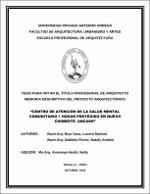Mostrar el registro sencillo del ítem
Centro de Atención de la Salud Mental Comunitario + Hogar Protegido en Nuevo Chimbote - Ancash
| dc.contributor.advisor | Amemiya Hoshi, Nelly | |
| dc.contributor.author | Ruiz Vaca, Lucero Marisol | |
| dc.contributor.author | Saldaña Flores, Nataly Andrea | |
| dc.creator | Ruiz Vaca, Lucero Marisol | |
| dc.date.accessioned | 2019-10-11T12:48:13Z | |
| dc.date.available | 2019-10-11T12:48:13Z | |
| dc.date.issued | 2019 | |
| dc.identifier.uri | https://hdl.handle.net/20.500.12759/5523 | |
| dc.description.abstract | En la presente investigación inicia desde un análisis y diagnóstico urbano del territorio de Nuevo Chimbote concluyendo en una propuesta arquitectónica, dando solución a una problemática social que es la salud mental, en la actualidad los servicios brindados en este sector son limitados ya que no existe una infraestructura enfocada en el tema, de tal manera se vuelve una necesidad que requiere ser cubierta para controlar las cifras elevadas de las personas con problemas de salud mental. Es notable como este tema no es priorizado por los gobiernos a pesar de su importancia y el impacto que tiene sobre la sociedad. La estructura de la investigación es mediante capítulos que contiene marco teórico, metodología, localización e investigación programática mediante datos cualitativos y cuantitativos, dando como resultado el diseño del proyecto arquitectónico acorde a las necesidades del usuario objetivo, este se fundamenta en los requerimientos del nuevo modelo de atención comunitario de la salud mental enfocado en ambientes que busquen la atención, rehabilitación y reinserción del paciente. Por otro lado, es importante brindar un servicio complementario a las personas en situación de calle que respalde que estas personas sean integradas con la población. Se tendrá como base 3 elementos: naturaleza, integración, infraestructura, que a través de un equilibrio generen un entorno de confort y mejora del paciente. | es_PE |
| dc.description.abstract | In the present investigation it starts from an urban analysis and diagnosis of the territory of Nuevo Chimbote concluding in an architectural proposal, giving solution to a social problem that is mental health, at present the services provided in this sector are limited since there is no infrastructure focused on the subject, in such a way it becomes a necessity that needs to be covered to control the high numbers of people with mental health problems. It is remarkable how this issue is not prioritized by governments despite its importance and the impact it has on society. The structure of the research is through chapters that contains theoretical framework, methodology, location and programmatic research through qualitative and quantitative data, resulting in the design of the architectural project according to the needs of the target user, this is based on the requirements of the new model of community mental health care focused on environments that seek patient care, rehabilitation and reintegration. On the other hand, it is important to provide a complementary service to people in street situations that support these people to be integrated with the population. It will be based on 3 elements: nature, integration, infrastructure, that through a balance generate an environment of comfort and improvement of the patient. | en_US |
| dc.description.uri | Tesis | es_PE |
| dc.format | application/pdf | es_PE |
| dc.language.iso | spa | es_PE |
| dc.publisher | Universidad Privada Antenor Orrego - UPAO | es_PE |
| dc.relation.ispartofseries | MEM_ARQ_519 | |
| dc.rights | info:eu-repo/semantics/openAccess | es_PE |
| dc.source | Universidad Privada Antenor Orrego | es_PE |
| dc.source | Repositorio Institucional - UPAO | es_PE |
| dc.subject | Salud mental | es_PE |
| dc.subject | Hogar protegido | es_PE |
| dc.title | Centro de Atención de la Salud Mental Comunitario + Hogar Protegido en Nuevo Chimbote - Ancash | es_PE |
| dc.type | info:eu-repo/semantics/bachelorThesis | es_PE |
| thesis.degree.level | Título Profesional | es_PE |
| thesis.degree.grantor | Universidad Privada Antenor Orrego. Facultad de Arquitectura, Urbanismo y Artes | es_PE |
| thesis.degree.name | Arquitecto | es_PE |
| thesis.degree.discipline | Arquitectura | es_PE |
Ficheros en el ítem
Este ítem aparece en la(s) siguiente(s) colección(es)
-
Arquitectura [415]

